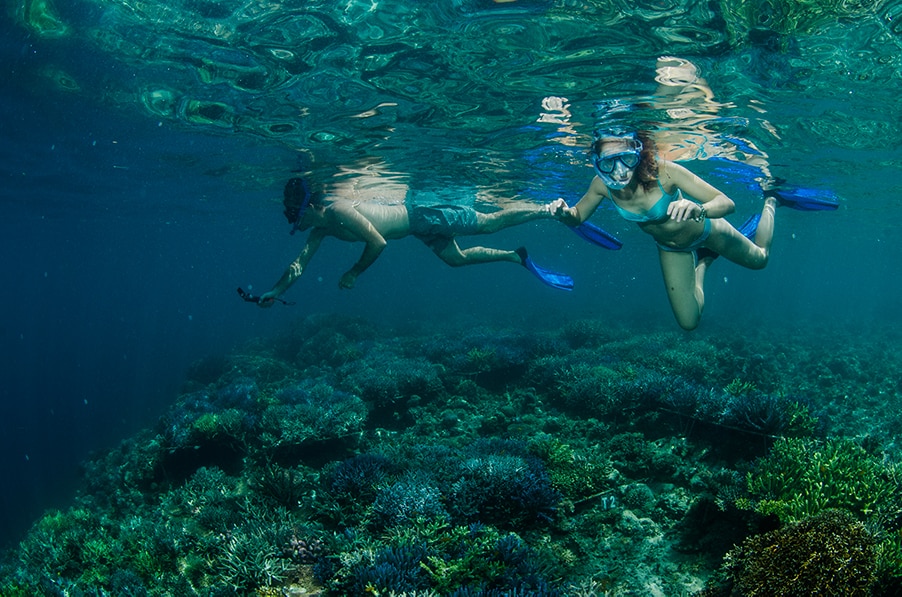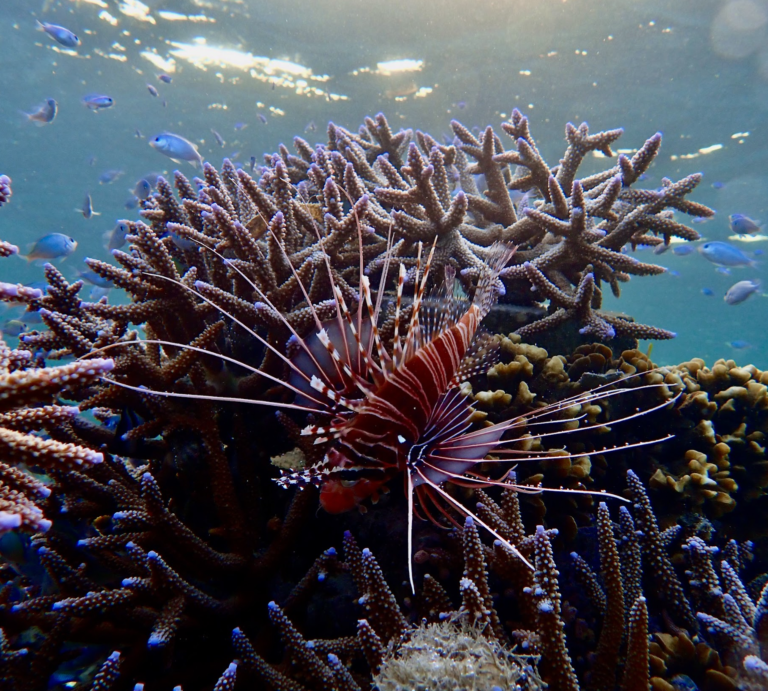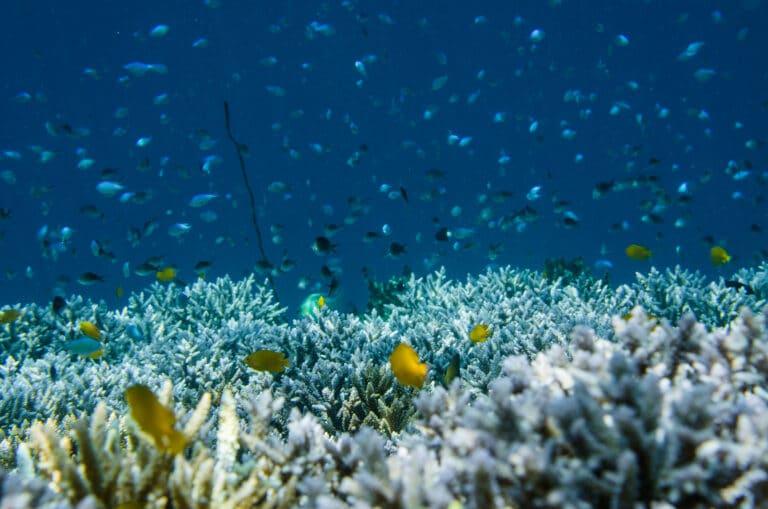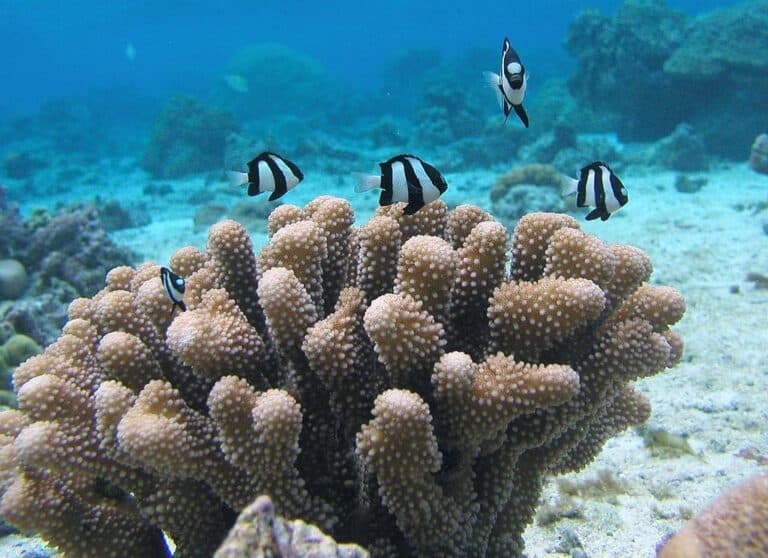Overall, what is the impact of UV filters in sunscreens on corals?

Around the world, coral reefs are facing a degradation driven by global and local human-derived pressures including climate change, coastal development, pollution, amongst others. In areas with riverine runoff or with high tourism affluence, there is an increasing concern about the effect that some sunscreen ingredients might have on corals [1]
Every year around the world at least 70 million trips are made to visit these ecosystems [2]. Even if coral related tourism represents a powerful tool to raise awareness, it has also been linked to the presence of UV filters in the water and sediments, thus exposing corals to chemical pollution [1,3,4]. Research on the effects of UV filters in corals is quite recent and has caused polemic in the scientific and cosmetic communities as well as amongst a wider audience. After a scientific literature review presented in three articles, here we gather some of the main findings as well as Coral Guardian’s position around this topic.
Overview of the effects
When included in sunscreens, UV filters protect the skin by absorbing or reflecting UV rays, thus mitigating the risks of diseases linked to solar radiation exposure and sunburn. Two main kinds of UV filters can be found in sun protection products: organic (or chemical) and inorganic (or mineral). Organic filters include oxybenzone (BP-3), octocrylene (OC), octinoxate or ethylhexyl methoxycinnamate (EHMC), amongst others. They act mainly by absorbing UV rays. On the other hand, inorganic filters include mainly zinc oxide and titanium dioxide, which act mostly by scattering and absorbing UV rays.
When released in water off the swimmers’ skin, UV filters can interact with marine biota through the water or the sediments. The study of these ingredients’ toxicity on coral has developed in the last few years because, as ecosystem-builder organisms, if there is an effect on them, the whole ecosystem is concerned.
The toxicity of the UV filters is normally addressed through laboratory trials, comparing biological indicators of the corals exposed to different concentrations (for example, bleaching assessed through color change or dinoflagellates’ concentration). These experiments are made over the short term, with an exposure to UV filters not exceeding some weeks, which leaves an open question about the long-term effect on them. According to our knowledge, studies have been made using only shallow tropical waters’ coral species, leaving cold-water coral species out of the discussion.
However, research has shown that some UV filters have a negative impact in some corals both in adult and planulae stages, but so far, the effects of organic filters are more widely studied than inorganic filters.
For instance, regarding organic filters, adult corals under exposure to oxybenzone suffered from bleaching, viral infection, and death acceleration [5, 4]. This same filter showed to have an impact on the planulae by overstimulating the skeleton’s formation, resulting in an encasement of the planulae in their own skeleton [3]. Some of these impacts were accelerated when combined with other factors like thermal stress [4], suggesting an open research field around the synergies between UV filters and other pressures.
Although less known, the exposure to other kinds of organic filters like ethylhexyl methoxycinnamate, or octinoxate (EHMC) or other benzophenones (BP) can also result in coral bleaching, mortality, and planulae settlement impact [6,7].
On the other hand, regarding inorganic filters, the main ingredients are zinc oxide and titanium dioxide, which can be used or not as nanoparticules (smaller than 100 nm). The use of nanoparticules in the formulations is made to limit the white trace left on the skin. These filters are often perceived as less toxic than the organic ones. However, research has found that the exposure to zinc oxide nanoparticles produced coral bleaching and microbial enrichment around the corals [8]. The exposure of titanium dioxide generated a loss in symbiotic microalgae of corals even at low concentrations, as well as bioaccumulation [8,9].
From research to practice… What can we do?
How are these laboratory results linked to the reality on the ground? There is a wide spatio-temporal variation in UV filters’ concentrations measured in coral reefs environments. In some areas the quantities of these ingredients in water and sediment are much inferior compared to the ones tested in the laboratories (see [1]). But in other areas the concentrations reach the ones found to be toxic in the experiments [4,3]. Therefore, there is a need of limiting the entrance of UV filters to marine environments.
The increasing mass of scientific research describing the effects of sunscreens on human and environmental health, combined with public awareness, has exerted an important pressure on the cosmetic sector to create products with no or little effect on the environment. In fact, part of the polemic about the research on the topic is because some studies are addressed by actors with a conflict of interest. Indeed, even if it is not the case for all the research, some studies are financed directly by the entities that have an economic interest in assessing the low impact of the products on the environment.
As a result of this pressure, more and more sunscreens in the market are labeled as “reef friendly”, often linked to the absence of some UV filters like oxybenzone, octinoxate or octocrylene. However, as mentioned before, these are not the only UV filters with negative effects on corals, making it hard to assess the lack of impact on corals (and even more so on reefs) based only on the presence of these filters. This is even more obvious considering that there is not much yet that is known about the toxicity derived from the interaction between the UV filters and other ingredients of the products in marine biota [10].
Therefore, these labels should be considered by the consumers only as an indication of the interest that the company might have in selecting ingredients with a low impact on marine environments. However, it does not guarantee a lack of impact of the products on reefs. Considering the evidence, it is rather hard to create an impactless sunscreen, with zero effect on the marine environment.
The issue about sunscreens is a debate between public health and ecosystem health, and what to prioritise between the two. On one hand the use of sunscreens is one of the main strategies to protect humans from skin cancer and other health problems linked to sun exposure. On the other hand, their interaction with biodiversity negatively impacts its resilience to other pressures. At Coral Guardian, we recognize it is a complex topic, and we don’t mean to simplify it. However, we do believe that efforts to minimize the negative effects of sunscreens should be supported. This, as long as they are based on scientific knowledge, and when they go beyond a plainly commercial strategy.
To conclude, we present here some general recommendations to keep in mind to limit the negative impact of sunscreens on coral reefs and marine biodiversity when visiting coral reef areas:
-
- Whenever possible, avoid direct sun exposure, especially during midday hours.
- Try and choose short periods of sun exposure, and protect the skin by using clothes and hats.
- When choosing your sunscreens, avoid products that include organic filters and nanoparticles of inorganic filters.
- It’s important to wait long enough after applying the sunscreen so it can dry on the skin. This will limitate the amount of sunscreen released in the water.
- Stay informed about the regulations/recommendations around the use of sunscreen products in the region you visit or live in.
For further information you will find:
Our series of articles around this topic.
[1] Wood, E. (2018) Impacts of sunscreens on coral reefs. ICRI Briefing. Online resource: https://www.icriforum.org/documents/impacts-of-sunscreens-on-coral-reefs/
[2] Spalding M., Burke L., Spencer A. Wood, Ashpole J., Hutchison J., Ermgassen P.z. (2017) Mapping the global value and distribution of coral reef tourism. Marine Policy (82), pp. 104-113, https://doi.org/10.1016/j.marpol.2017.05.014.
[3] Downs C.A. (2016). Toxicopathological Effects of the Sunscreen UV Filter, Oxybenzone (Benzophenone-3), on Coral Planulae and Cultured Primary Cells and Its Environmental Contamination in Hawaii and the U.S. Virgin Islands. Arch Environ Contam Toxicol 70 (2), pp. 265–288. DOI: 10.1007/s00244-015-0227-7
[4] Wijgerde T. et al, (2019). Adding insult to injury: Effects of chronic oxybenzone exposure and elevated temperature on two reef-building corals. Science of The Total Environment 773, 139030. DOI: https://doi.org/10.1101/2019.12.19.882332
[5] Danovaro R., Bongiorni L., Corinaldesi C., Giovannelli D., Damiani E., Astolfi P., et al (2008) Sunscreens cause coral bleaching by promoting viral infections. Environ Health Perspect, 116, pp. 441-447
[6] He, T., Tsui, M.M.P., Tan, C.J., Ng, K.Y., Guo, F.W., Wang, L.H., Chen, T.H., Fan, T.Y., Lam, P.K.S., Murphy, M.B. (2019a) Comparative toxicities of four benzophenone ultraviolet filters to two life stages of two coral species. Sci Total Environ, 651 (Pt 2), pp. 2391-2399, 10.1016/j.scitotenv.2018.10.148
[7] He, T., Tsui, M.M.P., Tan, C.J., Ma, C.Y., Yiu, S.K.F., Wang, L.H., Chen, T.H., Fan, T.Y., Lam, P.K.S., Murphy, M.B. (2019) Toxicological effects of two organic ultraviolet filters and a related commercial sunscreen product in adult corals. Environ Pollut, 245, pp. 462-471, 10.1016/j.envpol.2018.11.029
[8] Corinaldesi C., Marcellini F., Nepote E., Damiani E., Danovaro R. (2018) Impact of inorganic UV filters contained in sunscreen products on tropical stony corals (Acropora spp.) Sci Total Environ, 637–638 , pp. 1279-1285, 10.1016/j.scitotenv.2018.05.108
[9] Jovanovic B., Guzman H.M.(2014) Effects of titanium dioxide (TiO2) nanoparticles on caribbean reef-building coral (Montastraea faveolata) Environ Toxicol Chem, 33 (6) (2014), pp. 1346-1353, 10.1002/etc.2560
[10] Huang Y., Law J.C., Lam T.K., Leung K.S. (2020) Risks of organic UV filters: a review of environmental and human health concern studies. Sci Total Environ. Feb 10; 755(Pt 1):142486. doi: 10.1016/j.scitotenv.2020.142486.
Ces articles pourraient vous intéresser

The design of artificial reefs influences the ecological fate of restored reefs
Ewout Knoester’s team in Kenya has shown that the type of artificial reef structure used for coral restoration has an impact on the survival of…
19 November 2024
Sponsor spotlight : Alban from W2P
Tell us a bit about yourself 🙂 I am Alban Taravello, producer and founder of W2P Production. I am passionate about diving, deep-sea observation and video….
21 March 2023
How does the COP15 to the Convention on Biodiversity affect coral reefs?
Following the UN Climate Change Conference of the Parties (COP27) in Sharm el-Sheikh, Egypt (see our short review here), another key UN conference focusing on…
23 February 2023
How can reef fish-derived nutrients help corals under temperature stress?
The staggering biodiversity encountered in tropical coral reefs primarily results from the mutualistic symbiosis corals developed with endosymbiotic algae* from the family Symbiodinaceae. Thanks to…
20 January 2023
